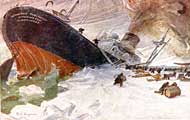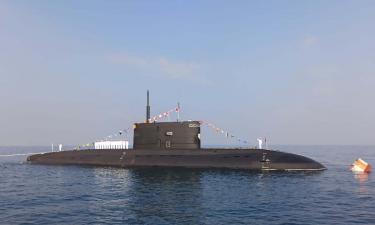Mystery of Russian Titanic
 Scientists failed to reveal the mystery of sunk Chelyuskin boat.
Scientists failed to reveal the mystery of sunk Chelyuskin boat.
Russian expedition did not find Chelyuskin which sank in the Vostochno-Chukotskoe Sea in 1934.
Divers and a special robot were working on the sea bottom, at the depth of 50 meters about 150 sea miles away from Chukotka Peninsula coast, where the boat was supposed to be.
In 1974 and 1979, expeditions were organized to the area where Chelyuskin had sunk, but at that time there was no technical capacity to find the boat in the depths of the sea. Only in 2004, a new expedition was organized.
The expedition was working from August 15 to August 25. It was headed by the general director of the Russian underwater museum Aleksei Mikhailov, he was assisted by the advisor of the governor of Chukotka region Alexander Borodin, the scientific advisor is Deputy Head of the Department of Scientific Tourism of the Russian International Academy of Tourism Joseph Rabinovich. Several scholars from Russian Academy of Science and eight experienced divers and divers-cameramen from Russia, Sweden and Singapore participated as well. State officials, military and businessmen assisted in funding the expedition.
The participants of Chelyuskin-70 project were equipped much better than their predecessors. Russian Academy of Science gave a special boat for research with the latest oceanographic equipment aboard. Russian Navy gave the expedition a TSL robot guided on TV. It can dive at the depth up to 6 kilometers and make a number of opеrations with no man’s participation. Previously, this technical wonder was used only for military purposes. All this allows the head of the expedition to be optimistic. Aleksei Mikhailov said, “We are not only going to dive under the severe conditions of Arctic, for the first time in history, but also to reveal the mystery of the sunk Chelyuskin by finding its log and the other documents”.
However, Chelyuskin boat was not found. 50-meter-depth is dangerous even for an experienced diver, and the sea depths were mainly researched by the robot. It dove according to the coordinates given by the expeditions of 1974 and 1979.
“It is dark and cold there, there are no items on the flat sea bottom”, said sea archaeologist Thomas Larsen who dove at the depth of 50 meters as well.
After a thorough examination of the sea bottom, the specialists decided to quit their search. The data which were considered true for 70 years, were false.
Expedition head Aleksei Mikhailov said that an object having the size of Chelyuskin, was found on the sea bottom with a radar and the robot. However, this object is deep under the bottom under the layers of bottom deposits, and there is nothing on the bottom surface.
A new expedition will be organized in 2005.
The last trip of Chelyuskin
The Arctic expedition on Chelyuskin boat started in 1933. It was headed by a famous polar explorer, Academician Otto Schmidt. The Chelyuskin’s mission was unprecedentedалая – to go from Murmansk port in Western Arctic to Vladivostok in the Pacific Ocean, on the boat having 7.500 tonnage. In this way, the Soviet government intended to prove that the Northern Sea Route is good for transporting cargos with no ice-breakers’ use.
In the fall of 1933 Chelyuskin started its trip. The entire country was following the expedition. At first, the expedition was of success, and passed 7,000 kilometers. However, in December 1933 the crew encountered misfortune - Chelyusking got stuck in the drifting icebergs in the Bering Strait. The boat was being dragged by the icebergs back to the Chukot Sea. On February 13, 1934 the boat sank between the capes of Severny and Uelen.
One participant of the expedition died, but 104 people, including 10 women and 2 little girls who were born during the trip, landed on the iceberg and set “Schmidt’s camp” there. All necessary items were taken to the iceberg from the boat, and this allowed the people to survive one month on the iceberg until the help arrived. On March 5, 1934, after 28 failed attempts, pilot Anatoly Lyapidevsky found the people from Chelyuskin and rescued the women and children from the iceberg. The rest 92 passengers and crew members were evacuated on April 13, 1934.
The polar pilots made 24 flights to rescue the expedition, and were awarded the Heroes of the Soviet Union titles. Rescuing the Chelyuskin expedition became a remarkable point of Russian history. However, the mystery of the boat’s sinking has not been revealed so far. There is version that the boat was crushed by the icebergs, but this is not known for sure.
Source: Russian media
Subscribe to Pravda.Ru Telegram channel, Facebook, RSS!




